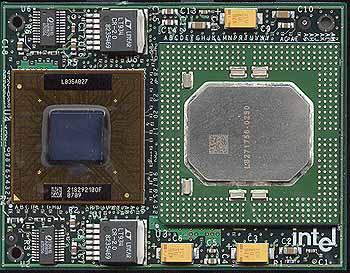The Situation at Hand
So Intel had a dilemma on their hands, like the neighbor that promised a lawnmower, Intel promised the Socket-8 users of 1996 and beyond an upgrade path to something better. While the patient investors in the Pentium Pro's now outdated technology waited for that anticipated "knock" on their doors, the rest of the market went crunching away with the migration to the Slot-1 architecture of the Pentium II or the Super7 architecture of the K6. Even at the introduction of the official replacement to the Pentium Pro, the Pentium II Xeon (which used an even larger interface, Slot-2), the users that once invested thousands of dollars into their "bleeding edge" processors were left out in the dust with an empty promise. From time to time, there would be the occasional rumor of the highly anticipated OverDrive processor for Pentium Pro users, however it seemed as if the stories were nothing but what they were classified as, rumors.
Luckily, late in 1998, Intel made the official announcement that the Pentium II OverDrive processor would finally make its debut. Since then, there has been little talk about the processor upgrade, and the release was hardly publicized, possibly because of a powerful "encouragement" to push users towards Slot-1 and away from upgrading the unsupported Socket-8 platform. In fact, if you pay a visit to Intel's Pentium Pro FAQ, you'll notice a large number of broken links, including a now removed General Background Questions section about the processor. It looks like the Pentium Pro has been tossed in Intel's great big retirement home…although not yet forgotten with the introduction of the Pentium II OverDrive.
The OverDrive

The original Pentium Pro processor never made it up above 200MHz, and 98% of all Pentium Pro motherboards never supported Front Side Bus frequency settings (back in the days of the Pentium Pro, it was just referred to as the "Bus" speed) above 66MHz. If you were lucky, your motherboard had support for the 3.5x clock multiplier so you could take your Pentium Pro 200 up to 233MHz if you had proper cooling, but that was pretty much it when it came to upgrading your system. Why not go out and buy a new motherboard and CPU and start all over with a nice Pentium II system? The problem with that solution was that, as many of you will be able to relate to, most users had a tremendous investment in Pentium Pro motherboards, especially those with on-board SCSI/RAID, as well as incredible amounts of EDO DRAM in excess of 512MB at times, so going out and replacing things like that with newer motherboards and half a gigabyte of SDRAM isn't the most economical solution. This is where Intel's idea of the OverDrive processor comes in.

Intel's goal for the OverDrive line of processors has been to provide a processor, with the on-board circuitry to configure itself, requiring only that the FSB frequency be provided by the motherboard. OverDrive processors are basically next generation, or later generation processors, stuck on a circuit board that allows for the processor to adapt to its environment to the extent that the OverDrive processor should be able to work perfectly in any system it is installed in. The goal is obviously extremely idealistic, and likewise, unattainable, however it does provide the basic outline for the functionality of the Pentium II OverDrive processor.










0 Comments
View All Comments